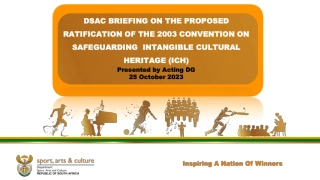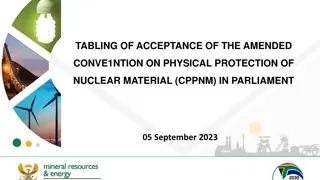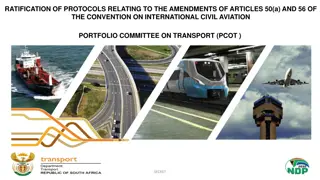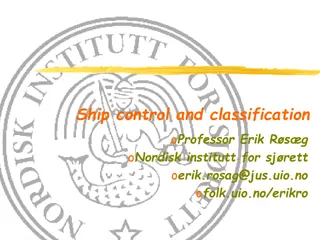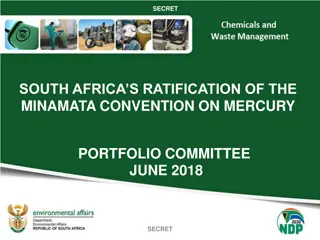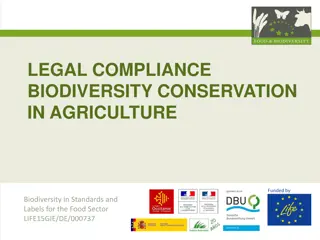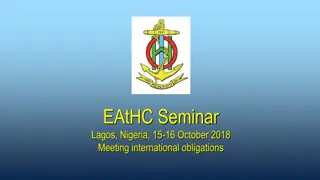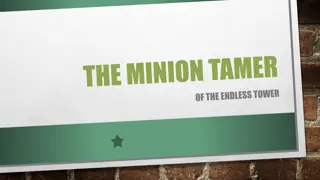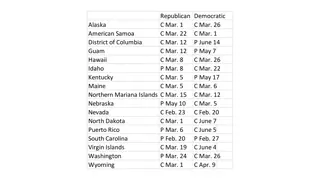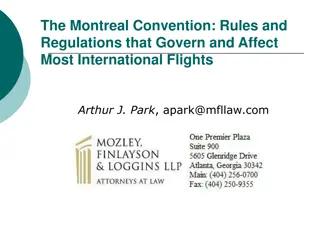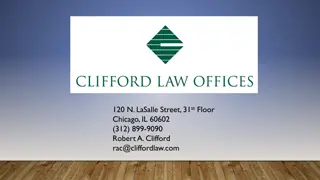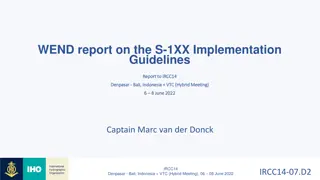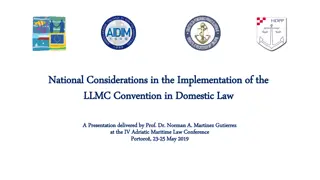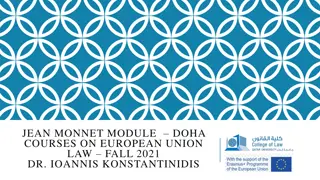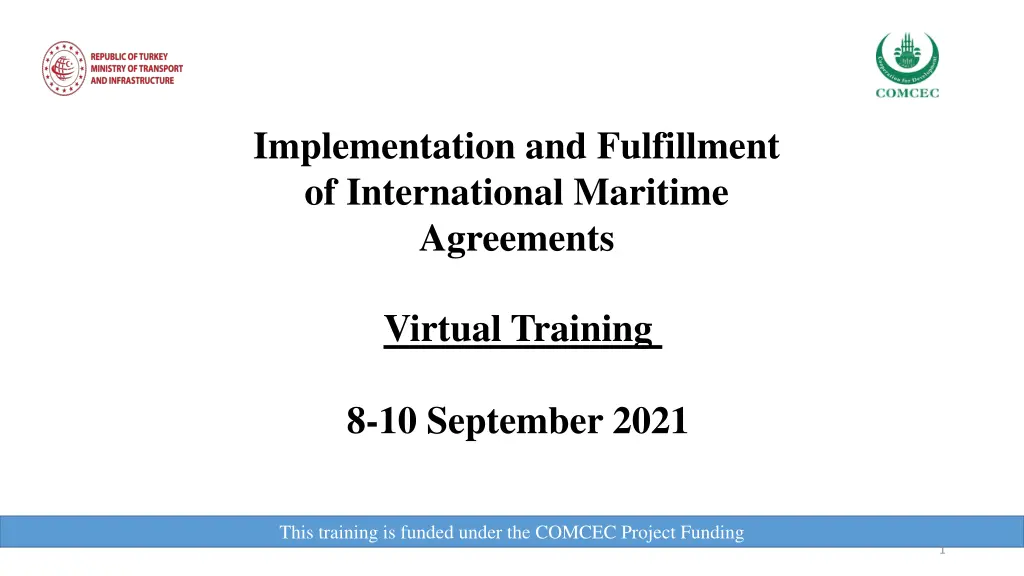
International Maritime Agreements Training: SOLAS Convention Overview
Explore a virtual training series on the implementation and fulfillment of international maritime agreements, focusing on the SOLAS Convention framework, scope, history, and significance in maritime safety and pollution prevention. Join experts and gain insights into key pillars of maritime regulations. Funded by the COMCEC Project.
Download Presentation

Please find below an Image/Link to download the presentation.
The content on the website is provided AS IS for your information and personal use only. It may not be sold, licensed, or shared on other websites without obtaining consent from the author. If you encounter any issues during the download, it is possible that the publisher has removed the file from their server.
You are allowed to download the files provided on this website for personal or commercial use, subject to the condition that they are used lawfully. All files are the property of their respective owners.
The content on the website is provided AS IS for your information and personal use only. It may not be sold, licensed, or shared on other websites without obtaining consent from the author.
E N D
Presentation Transcript
Implementation and Fulfillment of International Maritime Agreements Virtual Training 8-10 September 2021 This training is funded under the COMCEC Project Funding 1
SOLAS CONVENTION FRAMEWORK, SCOPE OF APPLICATION AND STRUCTURE Dr Tamer Yal n, Asst. Prof of Maritime Transportation, Piri Reis University 9-10 Sep 2021,Thursday and Friday This training is funded under the COMCEC Project Funding 2
FRAMEWORK Before the very serious accident with the Titanic, occurred on 14 April of 1912, after colliding with an iceberg, the history had already recorded other serious maritime accidents. This training is funded under the COMCEC Project Funding 3
The intention would be to keep the Convention updated through regular amendments, but in practice this was found to be very slow. It has become obvious that it is impossible to ensure the entry into force of amendments within a reasonable period of time. This training is funded under the COMCEC Project Funding 6
The SOLAS Convention is one of the three most important pillars of the international instruments, which regulate questions relating to maritime safety and pollution prevention, the other two are the International Convention Prevention of Pollution from Ships, the MARPOL Convention, International Convention on Standards of Training, Certification and Watch keeping for Seafarers, STCW Convention, for the and the 7
SCOPE OF APPLICATION of 500 gross tonnage or over and passenger ships on international voyages. As a general rule, the SOLAS Convention applies to cargo ships This training is funded under the COMCEC Project Funding 8
The main objective of the SOLAS Convention is to specify minimum standards for the construction, equipment and operation of ships, compatible with their safety. This training is funded under the COMCEC Project Funding 9
SOLAS 74 SOLAS CONTENT: chapters and each chapter has its own set of regulations. The SOLAS 1974 international maritime treaty comprises of 14 This training is funded under the COMCEC Project Funding 10
Chapter I General Provisions: Chapter II-1 Construction Chapter II-2 Fire protection, fire detection and fire extinction: This training is funded under the COMCEC Project Funding 11
Chapter III Life-saving appliances and arrangements: Chapter IV Radio communications: Chapter V Safety of navigation: This training is funded under the COMCEC Project Funding 12
Chapter VI Carriage of Cargoes: Chapter VII Carriage of dangerous goods: Chapter VIII Nuclear ships: Chapter IX Management for the Safe Operation of Ships: This training is funded under the COMCEC Project Funding 13
Chapter X Safety measures for high-speed craft: Chapter XI-1 & 2 Special measures to enhance maritime safety: Chapter XII Additional safety measures for bulk carriers: Chapter XIII Verification of Compliance Chapter XIV -Safety Measures for Ships Operating in Polar Waters This training is funded under the COMCEC Project Funding 14
SOLAS Chapter I General Provisions In the SOLAS Chapter 1; General Provisions, Surveys and certification of all the safety items, structure, machinery etc. are included. This chapter is further subdivided into 3 parts- Part A, Part B and Part C. This training is funded under the COMCEC Project Funding 16
A List of Inspections And Surveys Deck Officers On Ships Should Be Aware Of ensure the safety and seaworthiness of vessels. With maritime laws becoming more stringent with each passing year, sea-going vessels have to go through a series of inspections in order to meet minimum requirements to continue sailing. Periodic surveys and inspections of ships are carried out to This training is funded under the COMCEC Project Funding 17
What is Harmonised Survey System for Ships? On February 3, 2000, International Maritime Organization (IMO) adopted a harmonised survey system for ships, in order to alleviate the problems caused by survey dates and intervals between surveys which do not coincide, covering international shipping regulations including the codes and conventions of these following institutions: This training is funded under the COMCEC Project Funding 18
International Convention for the Safety of Life at Sea (SOLAS), 1974 The International Convention on Load Lines (LL), 1966 The International Convention for the Prevention of Pollution from Ships, 1973, as modified by the Protocol of 1978 relating thereto MARPOL 73/78 The International Code for the Construction and Equipment of Ships Carrying Dangerous Chemicals in Bulk (IBC Code) Code for the Construction and Equipment of Ships Carrying Dangerous Chemicals in Bulk (BCH Code) Code for the Construction and Equipment of Ships Carrying Liquefied Gases in Bulk (IGC Code). This training is funded under the COMCEC Project Funding 19
Features 1) A standard interval of one year between harmonised surveys for ships which could be based on any of the followings: Initial survey Periodical survey Renewal survey Intermediate survey Annual survey Additional survey This training is funded under the COMCEC Project Funding 20
2) A maximum period of validity of one year and five years for all passenger ship certificates and cargo ship certificates respectively 3) Three months extension for cargo ship certificates on the harmonised survey system for ships and one month for short voyages 4) At least two inspections are required to be executed of the ship s bottom in a five year period; maximum interval between the inspections has also been set at not more than thirty six months. This training is funded under the COMCEC Project Funding 21
5) A substantive harmonised system for merchant marine which credits a combined cargo ship safety certificate to replace existing safety equipment, safety construction and safety radio certificates 6) No more unscheduled inspections for harmonised system of classification for ships, while annual surveys have been made mandatory. Purpose Surveys, made in accordance with the harmonised survey system for ships, are purported to harmonize intervals between surveys of all legitimate certificates issued to all marine vessels. This training is funded under the COMCEC Project Funding 22
40 Ship Certificates and Documents that are Checked in a Port State Control (PSC) Survey followed by port authorities around the world to ensure that the foreign ships coming to their ports is in proper condition and complies by the standards put forth by international maritime authorities. A Port State Control (PSC) survey is a general practice that is This training is funded under the COMCEC Project Funding 23
There are forty important documents provided which can be checked by the Port State Control (PSC) Authority. Cargo Record Book Oil Record Book International tonnage certificate Minimum safe manning document certificate Medical fitness certificate Compliance and Safety Management Certificate (ISM Code) International Load Line Certificate This training is funded under the COMCEC Project Funding 24
International load line exemption certificate Dangerous Cargo Carrying Certificate International Oil Prevention certificate Cargo ship safety radiotelegraphy and radiotelephony certificates or GMDSS Certificate of fitness for carriage of liquefied gases in bulk Certificate of fitness for carriage of noxious liquid substances in bulk Passenger ship safety certificate Reports of previous Port State Control Surveys Shipboard Oil Pollution Emergency Plan Cargo Securing Manual Cargo loading and unloading plans This training is funded under the COMCEC Project Funding 25
Garbage record book and garbage management plan Ballast water management plan Document of operational limitations in case of passenger ships Muster List Reports on previous surveys apart from PSC Documents Fire control and safety plan Special purpose ship safety certificate Engine room and deck log book A/A Max Certificate for Ro-Ro Ships Records of tests and drills High Speed Craft Safety and Operational Certificate in case of high speed craft This training is funded under the COMCEC Project Funding 26
Certificate of Ships hull strength and machinery installation issued by the classification society Ship crew s certificate of competency for dangerous goods endorsement Certificate for carrying of dangerous chemicals in bulk Cargo ship safety certificate Intact stability booklet with damage calculations Stowage plan Record of oil discharge monitoring and control system for oil tankers Mobile offshore drilling safety certificate for offshore drilling vessels Documentation of authorization for carrying of particular cargo SAR Cooperation plan for passenger ships Cargo Ship safety certificate for ship s construction and equipment This training is funded under the COMCEC Project Funding 27
Regulation 19 Control: This regulation explains the jurisdiction of local government a foreign ship is voyaging, such as coast guard, port state etc. Regulation 20 Privileges: this regulation explains if the ship can or cannot claim any privileges depending upon the certificates it holds. Part C of Chapter 1 contains only one regulation, i.e. Regulation 21, which explains how a contracting government can carry out an inquiry for the ship which was involved in an incident and causalities and what kind of information needs to be collected and to be passed through. This training is funded under the COMCEC Project Funding 28
10 Important Things To Do During Ship Collision Accident Even with the latest developments in navigational equipment and communication systems, collision accidents between ships continue to occur around the world. This training is funded under the COMCEC Project Funding 29
Ship Collision just do not leave the ships damaged; they can also lead to major pollutions and claim several innocent lives. It should be understood that the following points are just for the purpose of guidance, and during a real situation, one s knowledge, seamanship and personal competence come in to play in handling the situation and saving lives. 1. Inform the Master and Engine room: 2. Immediately Send Distress Signal: This training is funded under the COMCEC Project Funding 30
3. Record Important Data: 4. Sound the Alarms: 5. Assess the Damage: 6. Take the Soundings: This training is funded under the COMCEC Project Funding 31
7. Take Immediate Action In Case of Damage: 8. Check For Oil Spill: 9. Reach The Nearest Port, If Possible: 10. Abandon The Ship Only if Everything Else Fails This training is funded under the COMCEC Project Funding 32
How P & I Clubs Work Procedure for Accident Response compilation of non-profit making organizations controlled by ship-owners and operators who communally contribute to certain third party liability risks related to their business especially their maritime businesses. Protection and Indemnity or better known as P & I Clubs are a This training is funded under the COMCEC Project Funding 33
The P&I Clubs provide insurance coverage of upto USD 1 Billion for compensation of damages by oil pollution from laden tankers as well as to tankers in ballast which is given in accordance to the International Convention on Civil Liability for Oil Pollution Damage (CLC). The Civil Liability Convention or CLC places a responsibility on the tanker owners to retain insurance and other financial security explicitly to cover oil pollution damages, and ensures that each tanker carries on board a certificate confirming to the fact that such a cover is enforced. This training is funded under the COMCEC Project Funding 34
Masters basic actions to P&I Accident Response to a third party claim, there are some definite actions which the master should always take into consideration and certain actions those which must be avoided. In the dire event that leads to an incident or an allegation giving rise This training is funded under the COMCEC Project Funding 35
To Do Notify owners / managers as soon as possible and send message to the relevant departments; With regard to the instruction given in club handbook, investigate each allegation that led to an injury or damage; Collect and collate evidences or documentation related to the incident, including defective equipment/machineries. Get the witnesses to write the statement of facts, pertaining to the exact cause or what they themselves experienced, saw and even heard. This training is funded under the COMCEC Project Funding 36
Do Not Allow any surveyor or a maritime lawyer on board the ship or to interrogate the crew members until they have satisfactorily identified themselves and presented suitable authorization; Allow surveyors or lawyers acting on behalf of opposite parties on board, unless you have been given the authority to do so; Produce any written matter or physical evidence to the lawyers or surveyors from the opposing party. When in doubt, do not hand over anything to anyone; Give a personal opinion as who or what is/was responsible for the events simply stick to the facts; Allow any of the crew members to express opinions without authorization; Admit any sort of liability, neither verbally nor in writing; Sign any document which you think is unclear or know contains incorrect information; Avoid letting persons from the Media to board the vessel unless authorized by Owners/operators. This training is funded under the COMCEC Project Funding 37
SOLAS Chapter II-1 Construction Subdivision and stability, machinery and electrical installations: This chapter of SOLAS Deals with watertight integrity of the ship, including the passenger s vessel and comprises of 7 parts, explaining the requirement for structural, machinery, electrical, stability and other criteria for a safe ship. Part A contains 3 regulations which explain the Application of this chapter on ships as per their keel laying. This training is funded under the COMCEC Project Funding 38
Part A-1 comprises of regulations explaining the requirement for the structure of the ship including protective coating, towing arrangements, deck equipment fittings, construction and drawings etc. This training is funded under the COMCEC Project Funding 39
Preparations For Emergency Towing Of Ship 10 Important Points the 10 important points that must be kept in mind in order to execute the procedure efficiently: 1. Safety: 2. Lights and Signals: 3. Draught: 4. Watertightness: 5. Securing Arrangements: This training is funded under the COMCEC Project Funding 40
6. Stability: 7. Rudder/Propellor: 8. Ship s Particulars: 9. Sea State: 10.The Emergency Towing Booklet: This training is funded under the COMCEC Project Funding 41
Part B of this regulation explains the stability and watertight integrity requirement. Under Part B 1, the regulations (Regulation 5 to 8) defines the necessary conditions for maintaining the intact stability of the cargo ship and passenger ship. This training is funded under the COMCEC Project Funding 42
Part B 2 comprises of 4 regulations (Regulation 9 to 17) which takes care of the watertight integrity of the ship (both passenger and cargo ship) by enlisting the constructional and testing requirements of watertight and other important bulkheads, and the provision of the double bottom on ships other than tanker ships. This training is funded under the COMCEC Project Funding 43
Part B 3 explains the requirement for the subdivision load line assignment for passenger ships. Part B 4 of this chapter comprises of 7 regulations ( Regulation 19 to Regulation 25) for the requirement of stability management explaining the inspections, preventions, damage control drills, and information for cargo and passenger ships. Part C focuses on different machinery installation in the engine room including the requirement of emergency installations in the passenger ships from regulation 26 to regulation 39. This training is funded under the COMCEC Project Funding 44
Part D of this chapter (from regulation 40 to 45) focuses on the electrical installation requirement for cargo and passenger ships including the emergency source and arrangements along with electrical safety and hazards. Part E clarifies the requirement for unattended machinery space under regulation 46 to 54 explicitly. Part F of this chapter gives the details about the alternative design and arrangement for the ship s machinery and electrical system under regulation 55 Part G explains the application and requirements as per the regulation 56 and 57 for the ships using low flash point fuels. This training is funded under the COMCEC Project Funding 45
SOLAS Chapter II-2 Fire protection, fire detection and fire extinction: This chapter elaborates the means and measures for fire protection in accommodation, cargo spaces and engine room for the passenger, cargo and tanker ship. Part A contains regulations 1 to 3 which explains the Application of this chapter on ships construction date. This training is funded under the COMCEC Project Funding 46
Part B of this chapter specifies the requirement to prevent fire and explosion on cargo ship including tankers. Part C of this chapter comprises of 5 regulations (Regulation 7 to Regulation 11) and focuses on the requirement to suppress the fire at the earliest, including detection and containment requirements. control of smoke and flames, This training is funded under the COMCEC Project Funding 47
Part D focuses on the escape of the seafarers or passengers in case of fire or any other emergency. Part E of chapter II-2 consist of Regulation 14 to regulation 16 providing information on the maintenance of the fire detection, fighting, and control equipment on cargo ships including tankers and passenger ships. Part F of this chapter gives the details about the alternative design and arrangement for the ship s fire safety under regulation 17. Part G contains a special requirement for the operations which are carried out on the tanker and bulk carrier ships such as helicopter operation (Regulation 18) giving details of different constructional, safety and firefighting arrangements. This training is funded under the COMCEC Project Funding 48
SOLAS Chapter III Life-saving appliances and arrangements: All the lifesaving appliances and there use in different situations according to the ship type is described in this chapter. This chapter comprises of 3 Parts. Part A contains 5 regulation which explains the Application of this chapter in different types of the ship along with the Definition of different terminology which is used in the chapter. This training is funded under the COMCEC Project Funding 49
Part B comprises of total 32 regulations (from Regulation no. 6 to 37) dealing with the requirements of life-saving appliances on passenger and cargo ships. Part C of this chapter gives the details about the alternative design and arrangement for ship s lifesaving appliances under regulation 38. This training is funded under the COMCEC Project Funding 50

